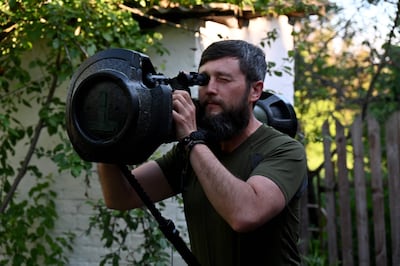Nato faces a significant challenge to adequately supply its new high readiness force with ammunition to defend against a potential Russian invasion, defence experts have said.
European countries have sent significant amounts of their weapon stockpiles to Ukraine creating concerns over equipping the alliance's new high readiness force of 300,000 troops on the eastern flank.
The National has learnt that there are a number of weapon systems that will take a long time to manufacture due to global supply shortages, including the NLAW anti-tank weapon.
While America has huge stockpiles of tanks, armoured vehicles and ammunition, European Nato forces do not and have witnessed a “noticeable reductions in inventory”, military analysts have said.
“There are issues around whether Nato has manufactured enough ammunition to meet its needs in the event of a war with Russia,” said military analyst Sam Cranny-Evans
“Parts of our defence industry have been neglected quite badly and the governments know that. To fix this is going to require a different type of relationship between defence departments and industry.”
The British-supplied NLAW anti-tank missile has proved highly successful against Russian tanks but it is difficult to obtain components for the system, including microchips provided by Taiwan.
The UK has given 5,000 NLAWs to Ukraine and it is understood that the government recently placed an order for a similar amount to the Belfast-based company that makes them.
However, the last major NLAW order was made in 2006 and now a number of components and machinery are difficult to replace.

Ben Wallace, the Defence Secretary, has held urgent talks with the top UK defence companies, including BAE Systems, requesting they ramp up production to resupply Ukraine and ensure the home defences are adequately supplied.
In its Strategic Concept announced on Wednesday Nato stated that it could not “discount the possibility of an attack against allies’ sovereignty” by Russia.
It will now assemble a force of 300,000 troops for the front line in Eastern Europe with 100,000 troops at “very high readiness” able to deploy within 10 days.
Light and heavy weapon systems, including air defence, artillery and tanks, will be “forward positioned” but there are questions whether they can be adequately supplied.
A number of smaller Nato countries have depleted their stockpiles, with the Czech Republic and Slovakia donating more relatively than any other country in terms of infantry fighting vehicles and tanks.
Poland has also supplied Ukraine with a quarter of its Soviet-era tank force sending 230 T72s out of its total of 860. It hopes to be “back-filled” by America supplying it with modern M1A1 Abrams tanks.
France has given about 15 out of its total of 70 advanced Caesar artillery pieces that have great accuracy and out-range Russian guns.

But there are questions over how readily Nato forces can build up stockpiles of artillery rounds that are proving effective in Ukraine.
Currently Ukraine is expending about 6,000 shells a day with the Russian figure approaching 20,000 rounds.
To build a credible deterrence Nato will have to create a stockpile to at least match the Russian expenditure, military experts have said.
“Can western industry meet the demand of 20,000 rounds a day when the demand signal for so long has been for exquisite precision-guided munitions as opposed to mass fires?” said Mr Cranny-Evans, of the London-based RUSI think tank.
“I personally don't believe they can right now. But if the political impetus is strong and determined enough, then there will be change. Because if you're not prepared to fight that long, grinding battle your deterrence is not credible.”
There is also a problem with the different sizes of various Nato ammunition as the artillery pieces sent to Ukraine have five different calibres.
However most of the combat vehicles sent are from stocks that are no longer widely used by Nato such as US Humvees or French VAB armoured vehicles.
Europe also retains strong air forces including fighter jets and attack helicopters that are largely superior to Russian aircraft.
Also, production lines for advanced precision guided munitions such as Javelin anti-tank missiles, Hellfire and Brimstone missiles are running well as there have been continuing orders.
Furthermore, defence observers say the weapons in Ukraine are causing significant attrition to Russian forces.
“Nato powers are drawing down their weapon systems but these are achieving real effects in Ukraine damaging and destroying Russian capabilities, which advances European security in places like the Baltics,” commented the defence blogger known as “Perun”.
A comment on his site mentioned Estonia sending 500 Javelin missiles to Ukraine in late February adding: “Every piece of Russian armour destroyed in Ukraine is one fewer system that can be used to invade the Baltics.”
Up to 800 Russian tanks have been lost in Ukraine.





































